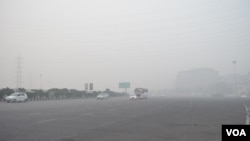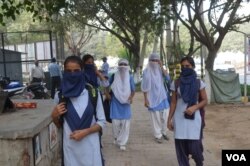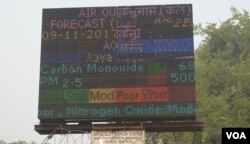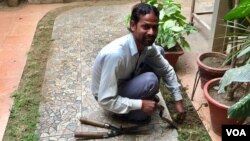In the Indian capital, New Delhi, winter was once a season of cool, crisp winds, bracing walks and picnics under a blue sky. But as the city remained enveloped in toxic gray smog this week, authorities rolled out a series of emergency measures to combat deadly levels of air pollution.
For five days starting Monday, the operation of private cars on Delhi's roads will be rationed, allowing those with odd and even number plates on alternate days. Construction and industrial activity has been banned, and most trucks will be barred from New Delhi to help reduce pollution that doctors liken to smoking 50 cigarettes a day. Schools are temporarily shut.
"This is the beginning of emergency action in this country for the first time," said Anumita Roychowdhury at New Delhi's Center of Science and Environment. "Now the real test is whether it is going to get implemented with absolute stringency."
Struggling to address its severe air pollution crisis, Delhi has lagged behind cities like the Chinese capital, Beijing, that have long had an emergency response system in place.
It is the second consecutive year that levels in the city have spiked to 30 times the safe limit set by the World Health Organization, prompting the city's chief minister to liken it to a "gas chamber."
Amid grim warnings about the health hazards of being outdoors in the acrid air, many huddled inside their homes. Doctors have advised city residents to even avoid a walk while the air quality remains hazardous.
Delhi's air, a toxic cocktail of vehicle fumes, construction dust and burning waste, has worsened amid the city's exponential growth. The pollution turns deadlier in winter, when calm winds hold the pollutants down.
While most attention has focused on the Indian capital, large swathes of North India, home to tens of millions of people, have been blanketed under the thick smog since Tuesday.
Of particular concern is the alarmingly high level of PM 2.5, the tiny particulate matter that gets embedded deep inside lungs and which doctors warn is extracting a heavy price on the health of residents.
During his three decades at work as a chest surgeon in New Delhi, Arvind Kumar, has noticed a huge difference. "When I look at the chest directly or through the telescope, I am rarely able to distinguish whether this guy is a smoker or a non-smoker because all lungs are now turning black," he said.
Doctors said there has been an increase in the number of patients arriving with breathing problems this week.
But tens of thousands of residents had no option to being outdoors. Gardener Daya Singh, who works in an upscale city neighborhood, said his eyes sting when he cycles six kilometers to work through the gray smog every morning, when pollution levels peak. "It's like there are chillis (hot peppers) inside my eyes. I feel my chest constricting."
At a chemist's shop in Delhi, respiratory masks are flying off the shelves even though doctors said the air is so filthy that they would only be of marginal use. Poonam Sharma bought one for her son. "I have options, I can stay at home also, but they have to go daily to college, school. They need it," she said.
Meteorologists said there would be a respite as wind speeds pick up soon. However the air quality will hover in the extremely poor category all through the winter season. And that is the worry.
Stressing the need for long-term action to tackle the Indian capital's air pollution crisis, the Center of Science and Environment's Anumita Roychowdhury pointed out, "the city cannot be on emergency mode all the time."
The wishlist is long: an expansion of public transport to reduce vehicle use in a city whose roads are routinely clogged with nine million vehicles due to a poor public transport system, cleaner fuel for industries and coal-fired power plants, an end to burning of waste.
In the immediate term, even as Delhi rolls out emergency measures to tackle the air pollution crisis, the solution to one of the main contributors to the city's dirty air remains elusive.
Every year at this time, farmers in neighboring states set ablaze 32 million tons of paddy straw to prepare their fields for the next sowing season. The acrid smoke worsens the pollution as it blows towards Delhi.
While burning crop stubble has been banned, Chief Minister of Punjab state Amrinder Singh questioned how, in the absence of a viable alternative, could he penalize farmers for trying to earn their livelihood.
The same question will be raised as temperatures dip further and many poor people light wood fires in and around the Indian capital to remain warm.












